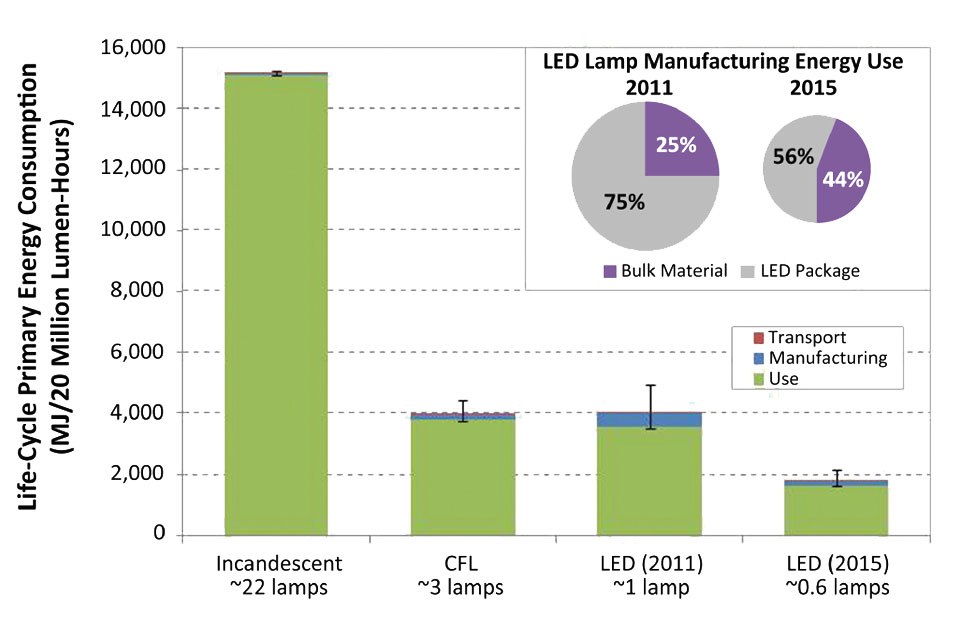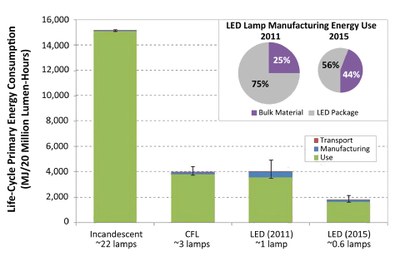DOE Releases Life-Cycle Energy Consumption Report - Incandescence vs. Fluorescent vs. LED Lamps
The U.S. Department of Energy (DOE) has published a report comparing the energy consumed over the entire life cycle for LED lamps, compact fluorescent lamps (CFLs), and incandescent lamps. Entitled "Review of the Life-Cycle Energy Consumption of Incandescent, Compact Fluorescent, and LED Lamps", it is based on existing life-cycle assessment literature of lighting products.
The report is the first installment of a larger DOE project to assess the life-cycle environmental and resource costs in the manufacturing, transport, use, and disposal of LED lighting products in relation to comparable traditional lighting technologies.
Light-emitting diode (LED) lighting has the potential to save energy and improve lighting quality and performance beyond that of many conventional lighting technologies. However, to truly gauge the full energy and environmental impacts of a lighting technology, its materials and energy resources must be traced over the entire life cycle. The report Review of the Life-Cycle Energy Consumption of Incandescent, Compact Fluorescent, and LED Lamps is the first installment of a larger U.S. Department of Energy (DOE) project to assess the lifecycle environmental and resource costs in the manufacturing, transport, use, and disposal of LED lighting products in relation to comparable traditional lighting technologies.
The assessment comprises three phases:
- Comparison of the total life-cycle energy consumed by LED and other lamp types based on existing life-cycle assessment (LCA) literature
- An LCA study of an LED lamp considering both the direct and indirect material and process inputs to fabricate, ship, operate, and dispose of the lamp
- The purchase, disassembly, and chemical testing of LED and conventional lighting products to study whether potentially hazardous materials are present in concentrations that exceed hazardous waste regulatory thresholds
Among this report's key findings:
- Available estimates indicate that the average life-cycle energy consumption of LED lamps and compact fluorescent lamps (CFLs) is similar, at approximately 3,900 megajoules (MJ) per functional unit (20 million lumen-hours). This is about one quarter of the incandescent lamp energy consumption—15,100 MJ per functional unit (20 million lumen-hours). In addition, by 2015, if LED lamps meet their performance targets, their life cycle energy use is expected to decrease by approximately one half.
- The “use” phase of incandescent, compact fluorescent, and LED lamps represents the most energy-intensive life-cycle phase, accounting for 90 percent of total life-cycle energy on average. This is followed by the manufacturing and transport phases, respectively. Transport represents less than one percent of life-cycle energy use for all lamp types.
- Most of the uncertainty in life-cycle energy consumption of an LED lamp centers on the manufacturing of the LED package. The low estimate indicates the LED package contributes to 0.1 percent of life-cycle energy, while the high estimate shows it could be as much as 27 percent. The average indicates that LED package manufacturing is about 6.6 percent of total life-cycle energy.
The full report with more detailed results can be downloaded at www.ssl.energy.gov/tech_reports.html.
DOE expects to publish the subsequent reports on the complete LCA project later in 2012.
To learn more about DOE Solid-State Lighting program activities, visit www.ssl.energy.gov.


